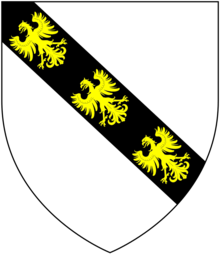Ernle baronets
The Ernle Baronetcy, of Etchilhampton in the County of Wiltshire, was a title in the Baronetage of England. It was created on 2 February 1661 for Walter Ernle, later Member of Parliament for Devizes.[1] He died 25 July 1682, and was buried at Bishops Cannings, Wiltshire. He was succeeded by his grandson, Sir Walter Ernle (1672–1690), 2nd Baronet, of Maddington, Wiltshire, who was, in turn, succeeded at his own death by his younger brother, Sir Edward Ernle (1673-1728/9), 3rd Baronet, P.C., MP. The third Baronet was succeeded by a kinsman, Sir Walter Ernle (1676–1732), 4th Baronet, of Conock, in the parish of Chirton, Wiltshire, who died childless, and was succeeded by his younger brother, the Reverend Sir John Ernle (circa 1680/1-1724), 5th Baronet, Rector of All Cannings, Wiltshire, who was predeceased by his only son.

The title is generally considered to have become extinct on the fifth Baronet's death in 1734. However, it was assumed by the late Baronet's kinsman Sir Michael Ernle (circa 1704–1771), a grandson of the first Baronet's younger brother Michael[2]. He also died without issue. The claim was then passed on to his younger brother, The Reverend Sir Edward Ernle (circa 1711/2-1787). Since his death in 1787, the title has not been claimed.
The Ernle baronets bore the coat-of-arms: Argent, on a bend sable, three eagles displayed or.
The estates of the family passed through female lines of descendants, and the surname Ernle, pronounced Earnley, after the Sussex parish from which it derived, now forms part of the orotund surname, Plunkett-Ernle-Erle-Drax, borne by Admiral The Honourable Sir Reginald Aylmer Ranfurly Plunkett-Ernle-Erle-Drax, younger son of the 17th Lord Dunsany whose wife, Ernle Elizabeth Louisa Mary Grosvenor Ernle-Erle-Drax, née Burton, was the eventual heiress of the senior line of the Wiltshire Ernle family. The surname continues among the admiral's descendants, being thus preserved whereas it would otherwise, apparently, have died out in the United Kingdom. No other current bearers of the surname worldwide are known to be related in the male-line to the Wiltshire and Sussex Ernle sib.
A one-name study of the surname Ernle and its many variants, including Erneley and Ernly, is being undertaken by a descendant of an earlier cadet line (descended from Thomas Ernle, gent., of Brembridge or Bremeridge manor, Dilton, parish of Westbury, Wilts., who was buried in Westbury parish church in 1595. He was the second son of John Ernle, Esq., of Burton Priory, Bishops Cannings, Wilts., who died in 1571) of the same Wiltshire family which originated with the mediaeval lords of the manor of Earnley on the Sussex coast.
For a more extensive account of the Ernle lineage, readers are advised to consult, with caution for their many errors, Burke's Extinct and Dormant Baronetcies, and the entries for the family listed in various editions of Burke's Landed Gentry, indexed by Burke's Family Index. For the baronetcy, the account in the Complete Baronetage should be examined.
Ernle baronets, of Etchilhampton (1660)
- Sir Walter Ernle, 1st Baronet (c. 1628–1682)
- Sir Walter Ernle, 2nd Baronet (c. 1671–1690)
- Sir Edward Ernle, 3rd Baronet (c. 1673–1729)
- Sir Walter Ernle, 4th Baronet (1676–1732)
- Sir John Ernle, 5th Baronet (c. 1681–1734)
- Sir Michael Ernle, 6th Baronet (d. 1771) [3]
- The Rev. Sir Edward Ernle, 7th Baronet (d. 1787)[3]
References
- Cokayne, George Edward, ed. (1903), Complete Baronetage volume 3 (1649-1664), 3, Exeter: William Pollard and Co, retrieved 5 May 2019
- Rev W H Jones, The History of the Parish of All Cannings, 1853, The Wiltshire Archaeological and Natural History Magazine, volume 11, page 192, https://books.google.com.au/books?id=unfzmzzthy0C&pg=PA192
- J and J B Burke (1838). A Genealogical and Heraldic History of the Extinct and Dormant Baronetcies of England. John Burke. p. 187. Retrieved 20 September 2018.
- Burke, Edward (1844). A Genealogical and Heraldic History of the Extinct and Dormant Baronetcies of Great Britain. London: John Russel Smith.
- Kimber, Edward and Richard Johnson (1771). The Baronetage of England. London: Woodfall.
- Burke's Extinct and Dormant Baronetcies
- The Complete Baronetage"
- Victoria History of the Counties of Sussex and Wiltshire.